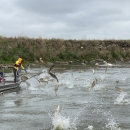Species that are considered high risk have a well-documented history of invasiveness in at least one location globally, and a high or medium climate match to the contiguous United States.
Roach (Rutilus rutilus) is a freshwater fish native throughout Europe and in Russia. The species generally feeds on benthic invertebrates, zooplankton, plant material, and detritus in both its native and introduced range. Humans have been known to use this fish as live bait, which has been recorded as the main vector for introductions. R. rutilus has become a prized fish by many fishermen. The history of invasiveness is high. This species has been introduced and spread. This fish has been known to impact populations of brown trout (Salmo trutta), rudd (Scardinius erythropthalmus), and perch (Perca fluviatilis), along with being a direct competitor for food with the tufted duck. R. rutilus was listed as an injurious wildlife species in 2016 under the Lacey Act by the U.S. Fish and Wildlife Service, thereby prohibiting its importation. The climate match with the contiguous United States is high. Most areas had medium matches with areas of high match found mainly around the Great Lakes region. The certainty of assessment is high. The biology, distribution, and history of invasiveness of the species is well documented. Overall risk for this species is high.



